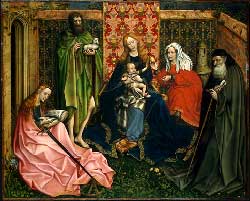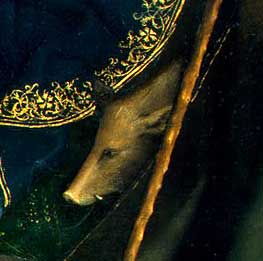Dutch, (c. 1375-1444)

-
Madonna and Child with Saints in the Enclosed Garden
- (c. 1440/1460), oil on wood panel
- 47.25 x 58.25 in. (119.8 x 148.5 cm.)
- National Gallery of Art, Washington DC
-
Editor’s Note:
In the painting above the garden enclosure is meant to represents both the virginity of Mary and the protective shelter of paradise – paradise being accessible to the faithful only through Christ and the intercession of the saints on their behalf.
Mary and Child are surrounded by saints — from left to right, Catherine, John the Baptist, Barbara, and Anthony Abbot with companion pig (detailed in the inset below).
This painting is now considered to probably be the work of an apprentice or follower of Robert Campin.
Here is a close up of the pig:

About the Artist
Robert Campin, Dutch, (c. 1375-1444). Campin was a Flemish painter who with the van Eycks ranks as a founder of the Netherlandish school. Campin was active in the city of Tournai (now in Belgium).
He was the head of a large workshop andepted commissions from city officials, churches, and the bourgeoisie. He also made designs for banners, coats of arms, and costumes, and sometimes produced manuscript illuminations. He had two famous pupils, Rogelet de la Pasture (Rogier van der Weyden) and Jacques Daret, both of whom worked for him until 1432.
Campin’s works are characterized by a robust and highly developed realism and concern for the details of daily life. In many works, textures of rich cloth and other surfaces are treated with an almost photographic precision and plants and animals are depicted with meticulous accuracy.
